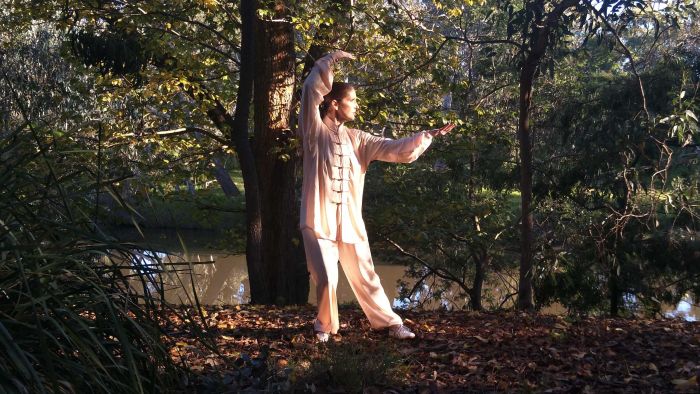In the early days of the COVID-19 pandemic, reports emerged of a novel method for managing mild cases of the disease.
In field hospitals in Wuhan, patients were encouraged to practise Qigong — an ancient Chinese form of exercise incorporating focused breathing and gentle movement.
But while eyebrows may have been raised among some Westerners, Albert Yeung, an Associate Professor at Harvard Medical School with a major in epidemiology, said Qigong was a helpful recovery tool for a range of diseases.
“First, to put this in context, Qigong wasn’t the sole treatment for people with COVID-19,” Yeung said.
“When you practise Qigong you undertake slow, deep breathing which helps to regulate the autonomic nervous system … so this helps a lot with our recuperation and self-healing.”
Qigong is related to, but distinct from, the more well-known Tai Chi (Taijiquan), a martial art that has been practised in China for self-defence and health benefits since the 16th century.
Byeongsang Oh, an Associate Professor at the Sydney Medical School and chief executive of the International Medical Tai Chi and Qigong Association, had studied the impact of both Tai Chi and Qigong on quality of life in cancer patients, and said they had similar health and wellbeing impacts.
“After 10 weeks, in addition to standard cancer treatment, the Qigong intervention group showed improvements in fatigue, mood (anxiety and depression) and levels of inflammation biomarkers.”
Mental ‘game-changer’




Tara Brayshaw is the principal of JinLi Wushu-Tai Chi, a Qigong and Tai Chi school in Melbourne. She was drawn to Qigong 28 years ago after her own cancer scare.
At the time, Brayshaw worked in a high-stress advertising job with “crazy hours” and said she knew she needed to do something physical, as well as something that would help her “de-stress”.
“Mentally, it was an absolute game-changer for me,” Brayshaw said.
“I got out of my first class and thought, ‘I haven’t thought about work for an hour’. I was completely hooked.”
Under the tutelage of her master, Brayshaw went on to become the first woman in Australia to hold an executive role on a number of boards, including the peak body for Chinese Martial Arts in Australia, the Australian Kung Fu Wushu Federation.
Citing an additional range of physical benefits, such as increased flexibility and motion through her joints, Brayshaw said finding Qigong and Tai Chi was “the greatest gift I’ve ever been given”.
Having established JinLi five years ago, she was now passionate about passing on her knowledge of the arts to her 250 students, many of whom arrived at the school looking for similar kinds of respite.
A ‘sense of peace’




One of those students is Hannah Macdougall, a dual Paralympian and bronze medallist who has represented Australia in swimming and cycling.
Macdougall, who was aiming to qualify for the 2021 Paralympic Games in Tokyo, credited Tai Chi and Qigong as one factor in producing some career-best performances over the past two years.
“I took it up several years ago, after I got back from a [cycling] World Championships where I’d had a crash,” Macdougall, who was born without her right foot, said.
“I was injured and working through that. I put my body into a state of starvation and then put on 8 kilos, broke up with my boyfriend and found out mum had cancer.”
Macdougall said she heard about the benefits of Tai Chi and Qigong through a podcast, from an elite runner talking about how helpful it had been for her energy levels.
“I was flat as a tack, so I googled it and found JinLi. I went along and felt so welcome in the class, it was just beautiful,” she said.
“I really loved how it was so different to everything I’ve done before in elite sport; it’s slow and I’m really bad at it.
Medication through movement
It’s a sentiment shared by many more of Brayshaw’s students.




Pauline Farrell, 71, took up Tai Chi and Qigong 14 years ago after spending a decade caring for her husband with cerebral palsy. She said she was initially interested in Tai Chi because she thought it may help with a prolapsed disc that forced her to give up tennis.
“My husband also really encouraged me to do it, to get out of the house. And I felt better, I had more confidence, was fitter, stronger, my back was getting so much better, I was socialising and meeting new and lovely people,” she said.
“But it also helped me be a better carer for my husband: I was excited to go home after I did it, because I’d had that little break in the normality of my daily routine.”
Farrell’s husband died seven years ago, but she continued with her Tai Chi and Qigong practice because of other benefits she had noticed, like improvements in her memory.
“As I get older I need to learn to remember things. I had no idea Tai Chi and Qigong had lots of different forms,” she said.
No-one can better attest to this than 35-year-old Loretta Bozelle, who sustained an acquired brain injury in a head-on car collision when she was 19.




After the accident, Bozelle had to re-learn to walk, and was heavily reliant on opioids for pain relief.
She lived with a permanent weakness down the right side of her body, and said her occupational therapist recommended Tai Chi or Qigong because of its “neuroplastic” benefits.
“I notice I have better awareness now, clarity and mobility,” she said.
Bozelle has now commenced training to become a Tai Chi and Qigong instructor, and wants to educate others with disability or brain injury about “just how much it can offer them”.
“I don’t think I would be here without Tai Chi or Qigong. I have seen it change my life and the lives of a lot of other people. I want to be able to give other people who are in similar situations the same opportunity as me.”







